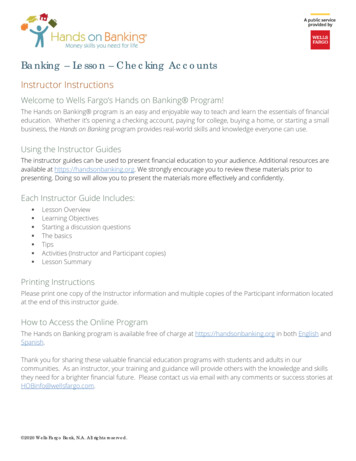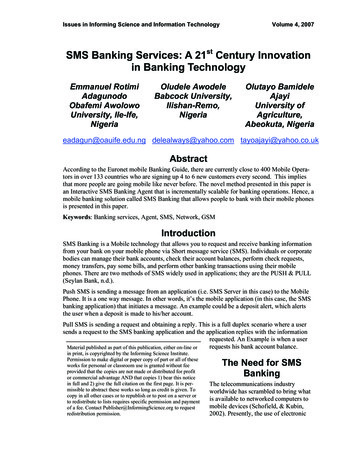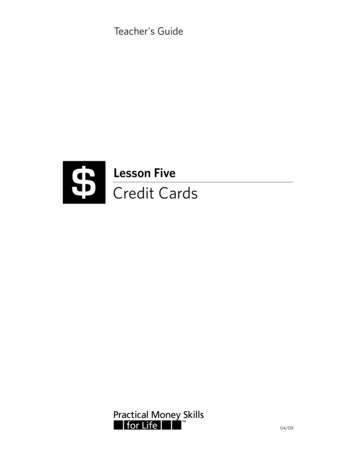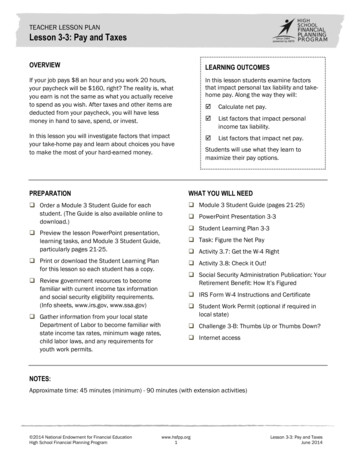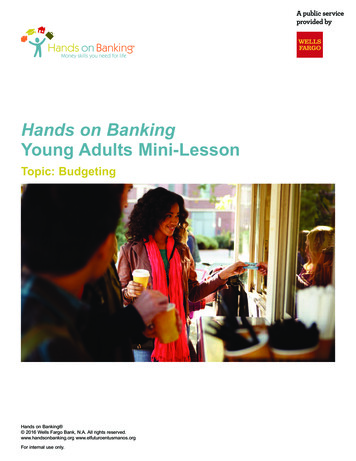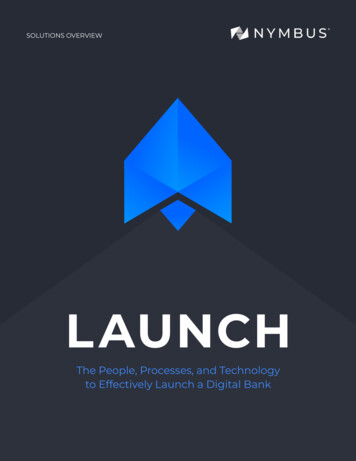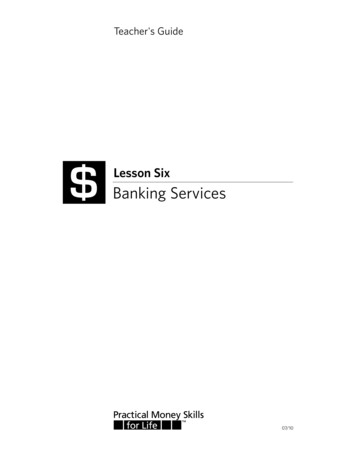
Transcription
Teacher's Guide Lesson SixBanking Services07/10
banking services websitesStudents will make wise choices about their banking services once theyunderstand such fundamentals as: selecting and managing a bank account; usingdebit cards; and safeguarding personal information against identity theft.For related links and resources on this lesson, lmoneyskills.com banking servicesteacher’s guide 6-i
banking services lesson outlineoverviewIf the fee for an ATM transaction to withdraw money is 1 and a person withdraws moneytwice a week, the banking fees for that person will be 104 a year. Over a five-year period,those fees invested at five percent would grow to more than 570.Most students know that banks and other financial institutions (credit unions, savings and loanassociations) offer a variety of services. However, few people know how to make wise choiceswhen using financial services. In this lesson, students will learn about the different types offinancial service products available and the features of each.When selecting a checking account, remind students to consider the required balance, monthlyfees, interest earned, cost of printing checks, and charges for other fees and services.goals Provide practice in comparing and evaluating various banking services, including checkingand savings accounts, debit cards/ATM, and online banking. Perform the tasks associatedwith maintaining checking and savings accounts.lesson objectives Understand the services offered by banks, savings and loans, and credit unions List some of the factors to consider when shopping for bank services Understand the responsibilities of having a checking account Write checks and keep a running balance in a checkbook Describe how to deposit a check Read and interpret a checking account statement Reconcile a checking account using a checking account statement and a check register Describe what an ATM card is and explain how it is used Describe what a debit card is and explain how it is usedpresentation slides6-Abeware of these high-cost financial services6-Bcomparing checking accounts6-Copening a checking account6-Dmaking a deposit6-Eendorsing a check6-Fwriting a checkwww.practicalmoneyskills.com banking servicesteacher’s guide 6-ii
banking services lesson outline6-G keeping a running balance: check transaction, ATM card transaction,debit card transaction6-Hreading a bank statement6-Ireconciling a checking account6-Jelectronic banking services6-Ksmart cardsstudent activities6-1Choosing a Checking Account6-2 Using the guidelines provided in class, have students shop for a checking account Discuss what they found. Which bank or credit union would they choose? Why?Keeping a Running Balance in a Check Register 6-3Reading and Interpreting a Bank Statement 6-4Have students answer the questions regarding the sample bank statementReconciling an Account 6-5Using the examples provided, have students keep a running balance in a check registerUsing the examples provided, have students reconcile the example accountLesson Six Quizsupplemental materials Banking Terms A Primer on Debit and ATM CardsFor more information, please refer to the Appendix.www.practicalmoneyskills.com banking servicesteacher’s guide 6-iii
banking services target audiencesLearning activities appropriate to varied target audiences for lesson sixactivityteenagers(14-18)young adults(19-25)adults(26 )Survey/InterviewStudent Activity 6-1Student Activity 6-2Student Activity 6-3Student Activity 6-4Web ActivityLesson Six Quiz 6-5www.practicalmoneyskills.com banking servicesteacher’s guide 6-iv
banking services teaching notesfinancial institutions and services1.Bank services Checking and savings accountsInterestAutomatic deposit and paymentStorage of valuablesTransfer of moneyOverdraft checkingTraveler’s checksFDIC (Federal Deposit Insurance Corporation)Credit and debit cardsCertificates of Deposit (CDs)ATMs2.Savings & loans (S&Ls)3.Credit unions4.How banks differ from savings & loans and credit unionsadvantages/disadvantages of havinga checking accountchoosing a checking account1.Monthly fees2.Per-check charges3.Balance requirements4.Interest rate5.How rates are calculated6.How soon you can draw against a deposit7.Bounced check charges On your check On a check you deposited8.ATM charges9.Debit card charge10. Stop payment fees11. Charges for printed checks12. Locations/number of branches13. Bank hours14. Online banking option15. Bill pay optionwww.practicalmoneyskills.com banking servicesdiscussionsurvey/interview:Have students talk to othersto obtain informationabout financial servicesthey nt activity 6-1teacher’s guide 6-v
banking services teaching notesshopping for a checking accountopening a checking account1.Signature authorization card2.The contract and what it means3.Initial depositmaking a deposit1.Writing a deposit slip2.Endorsing a check Blank endorsement Restrictive endorsement Special (or full) endorsement3.Depositing a check Direct deposit Manual depositwriting a check and keeping a running balance1.Writing a check2. Entering information about a check in your checkregister3.student activity 6-1discussionslide 6-Cslides 6-D & 6-Ediscussionstudent activity 6-2Keeping a running balance in your check registerwww.practicalmoneyskills.com banking servicesslides 6-F & 6-Gteacher’s guide 6-vi
banking services teaching notesusing an ATM card and keepinga running balanceStudents may wish to visit a local bank to find this informationon their own.What it is2.What it looks like3.Advantages of using4.Disadvantages of using5.How to use: Choosing a personal identification number (PIN)6.What it costs7. Entering information about an ATM transaction inyour check register8.Keeping a running balance in your check register1.using a debit card and keepinga running balanceBecause debit cards are widely used, a local bank officerwould be a good guest speaker for this topic.1.What it is2.What it looks like3.Advantages of using4.Disadvantages of using5.Difference from a credit card6.How to use it7.What it costs8.Where it is accepted9.What it replacesdiscissionstudent activity 6-2supplemental materialdiscussionsupplemental material10. Entering information about a debit card transactionin your check register11.Keeping a running balance in your check registerwww.practicalmoneyskills.com banking servicesteacher’s guide 6-vii
banking services teaching notesinterpreting a bank statement andreconciling an account1.Reading a bank statement2.Reconciling an accountChecking the bank statementVerifying checks in the check register Verifying deposits and ATM transactions Verifying debit card transactions Correcting entry errors in the check register Correcting deposit or ATM transaction amountsin the check register Correcting debit card transaction amounts in thecheck register Correcting errors of omission in the check register Finding outstanding transactionsdiscussionstudent activity 6-3 3.Practice reading a bank statement4.Practice reconciling an account student activity 6-4slide 6-H Have students supplement this activity bybalancing their parents’ accountsonline and electronic banking 24/7 account access Direct deposit Automated bill payments Money transferslesson six quizwww.practicalmoneyskills.com banking servicesquiz 6-5teacher’s guide 6-viii
keeping a running balance answer keyrecord deposits and keep a running balance in the checkbookregister below.1. On May 26, your balance is 527.96.2. On May 27, you write check #107 to your landlord, Mrs. Wilson, for 226.00.3. On May 28, you use your check card at Foodland for 22.52.4. On June 1, you write a check for 156.32 to Bank of Illinois for your car payment.5. On June 1, you realize your check to the Bank of Illinois should have been for 165.23, so youvoid the first check and write a new check for 165.23.6. On June 2, you write a check to Interstate Phone Service for 62.77.7. On June 2, you use your ATM card to withdraw 20.00.8. On June 15, your paycheck for 425.00 is automatically deposited.9. On June 15, you use your check card at Gifts Plus to buy a 18.99 birthday present foryour mother.10. On June 15, you write a check for 246.45 to State Ranch to cover car insurance premium.11. On June 22, you transfer 100.00 online from your checking account to your savings account.12. On June 24, you use your check card at Gas Up to fill up your car. You spend 12.88.13. On June 28, you use your ATM card to withdraw 30.00 from your checking account.527 96226 00226 00301 9622 5222 52279 44156 32156 3225 12165 23165 23114 2162 7762 7720 0020 0051 4431 44www.practicalmoneyskills.com banking servicesstudent activity key 6-2
keeping a running balance answer key31 44425 00425 00456 4418 9918 99246 45246 45437 45191 00100 00100 0091 0012 8812 8878 1230 0030 0048 12use the check register you just completed to answer thefollowing questions:1. What was your account balance on May 30? 279.442. Could you have paid your car insurance payment on June 1 instead of June 15? If not, why?No—the payment was 246.45 but the account balance on June 1 was only 114.213. The love of your life has been in a bad mood lately, and you think an expensive present mighthelp. You’ve found a leather jacket on sale for 189.00. Can you afford to buy the jacket on June8? What will your account balance be if you do?No—the account will be overdrawn by 157.564. The hottest new band in town has just released a CD. It costs 21.99. Can you afford to buythe CD on June 2? What will your account balance be if you do?Yes— 9.455. What was your account balance after you withdrew 30.00 on June 28? 48.126. What was the amount of check #111, to whom did you write it, and for what? 246.45 to State Ranch for a car insurance paymentwww.practicalmoneyskills.com banking servicesstudent activity key 6-2
reading a bank statement answer keyusing the bank statement information on the next page, answer thefollowing questions:1. What period does this statement cover?5/20/09–6/18/092. What is the account number of this statement?0471-6783. How many deposits were made and what were the amounts?Three, for the amounts of 1,200, 521.78, and 258.904. How many checks cleared and what was the total dollar amount of the checks that cleared?Six, for a total amount of 1,590.255. Were there any ATM withdrawals? If so, how many were there and what was the total amount?Yes—three for a total amount of 80.006. What is the total of all withdrawals (checks, ATM transactions, check card transactions,service charges)? 1,670.257. What is the new balance of the account? 922.478. Did check #182 clear?Yes9. What was the amount of check #183? 217.5410. Did check #185 clear?No11. What was the amount of check #181? 15.00www.practicalmoneyskills.com banking servicesstudent activity key 6-3
reconciling an accountITEMS OUTSTANDINGNUMBERAMOUNTenterThe New Balance shownon your statement 103.69addAny deposits or transfers listedin your register that are notshown on your statement 253.17total 253.17calculate the subtotal 356.86subtractYour total outstandingchecks and withdrawals- 36.31TOTALcalculate the ending balanceThis amount should be thesame as the current balancein your check register 320.55use the check register you just completed to answer thefollowing questions:1. What is the new balance shown on the statement? 103.692. What is the total amount of deposits listed in the check register but not shown onthe statement? 253.173. What is the sum of the new balance and the deposits not shown on the statement? 356.864. What is the total amount of outstanding checks and withdrawals? 36.315. What is the ending balance? 320.55www.practicalmoneyskills.com banking servicesstudent activity key 6-4
lesson six quiz: banking servicesanswer keytrue-falsefA pawnshop offers loans to people starting their own business.1. 2.t3.t4.t5.fOpening a checking account requires completing a signature card.A blank endorsement allows anyone to cash a check.A “smart card” stores a person’s bank balance right on the plastic card.An outstanding check refers to one written on an account with a very low balance.multiple choiceCThe highest loan rates usually6. occur when borrowing from a:A Obtaining cash from an ATM8. is similar to:A. bankA. writing a checkB. credit-card companyB. making a depositC. pawnshopC. opening a new accountD. credit unionD. earning interest on your accountB7. A is used to addfunds to a bank account.A. checkB. deposit slipC. signature cardD. withdrawal slipB9. A service charge on your bankstatement will result in:A. a higher balanceB. a lower balanceC. earning more interestD. more outstanding checkscase applicationA recent bank statement for Tracy Gray revealed various service charges and fees of over 10. Howmight Tracy reduce her costs for banking fees? Tracy should start by analyzing her financial serviceshabits. For example, if she uses an ATM often, the fees could be high. Or, if her checking account goes lowshe may have to pay a monthly fee or other charges for overdrawn accounts. If her fees are still high aftercareful use of banking services, she should compare the costs at other banks or a credit union and considermoving her account.www.practicalmoneyskills.com banking servicesquiz key 6-5
lesson sixbanking servicessupplemental materials04/09
banking termsaccountMoney deposited with a financial institutionfor investment and/or safekeeping purposes.capitalassetsItems of monetary value (e.g., house, land,car), owned by an individual or a company.cashMoney in the form of paper and coins(e.g., U.S. dollars and cents). In banking,the act of paying a check.atmAcronym for automated teller machine.balanceAn outstanding amount of money. Inbanking, balance refers to the amount ofmoney in a particular account. In credit,balance refers to amount owed.bankAn establishment for lending, issuing,borrowing, exchanging, and safeguardingmoney.bondAn IOU issued by a corporation, the U.S.government, or a city and held by thelender as receipt that the business orinstitution has borrowed a specific amountof money. All bonds pay interest yearly andare payable in full at a specified date writtenon the bond.bounced checkA check that a bank has refused to cashor pay because there are no funds to coverit in the account.canceled checkA “used” check that has been paid andsubtracted from the check-writer’s account.Canceled checks have extra data on themfrom the bank.www.practicalmoneyskills.com banking servicesA stock of accumulated wealth used oravailable for producing more wealth.cashier’s checkA check issued by a bank, drawn on its ownfunds rather than on one of its depositors.certificate of depositA savings account in which an individualpromises to deposit the money for a setperiod of time, for which the bank typicallypays higher interest than a regular savingsaccount.charge cardA plastic card that gives access to a lineof credit. The line of credit is theoreticallylimitless, but users are expected to repaytheir balance in full every month.checkAny written document instructing a bank topay money from the writer’s account.check cardSee debit cardchecking accountAn account for which the holder can writechecks. Checking accounts pay less interestthan savings accounts, or none at all.clearA check “clears” when its amount is debited(subtracted) from the payer’s account andcredited (added) to the payee’s account.supplement 6-1
banking terms (continued)collateralcredit scoreAnything that a bank accepts as securityagainst the debtor’s not repaying a loan. Ifthe debtor fails to repay the loan, the bankis allowed to keep the collateral. Collateralis most commonly in the form of real estate(e.g., a home).A credit score is a rating of your use ofcredit based on: your payment history;amount owed; the length of your credithistory; new credit; and the types of credityou use. Scores can range from 300 to 850,and the higher the score, the better yourrating. Scores affect the terms and interestrates on the loans you receive.commercial bankNongovernmental financial institutions.Sometimes called full-service banks becausethey provide a wide range of services, suchas checking and savings accounts, credit andloan arrangements, and safety deposit boxrentals. Commercial banks also sell andredeem U.S. savings bonds.compound interestInterest calculated not only on the originalprincipal, but also on the interest alreadyaccrued.creditIn business, buying or borrowing on thepromise to repay at a later date. In anycredit arrangement there is a creditor (aperson, bank, store, or company to whommoney is owned) and a debtor (the personwho owes money). In bookkeeping, a sumof money due to an individual or institution.credit bureauAn agency that checks credit informationand keeps a complete file on people whoapply for and use credit.credit cardA plastic card that gives access to a line ofcredit. Users are limited in how much theycan charge, but they are not required to repaythe full amount each month. Instead thebalance (or “revolve”) accrues interest like aloan. No interest is owed if the balance ispaid in full each month.www.practicalmoneyskills.com banking servicescredit unionA member-owned financial institution,either state or federally chartered.currencyMoney—anything used as a commonmedium of exchange. In practice, currencymeans cash, particularly paper money.Bankers often use the phrase “coin andcurrency” to refer to cents and dollars.debitA bookkeeping term for a sum of moneyowed by an individual or institution; acharge deducted from an account.debit card(also known as check card)A banking card enhanced with ATM(automated teller machine) and point-of-sale(POS) features that can be used to purchasegoods and services electronically. Transactionsare deducted from the cardholder’s checkingaccount either immediately or within one tothree days. Depending upon the type ofcard, a debit card may require a signature orentering a PIN.supplement 6-2
banking terms (continued)demand depositA checking account.deposit slipAn itemized slip showing the exact amountof paper money, coin, and checks beingdeposited to a particular account.depositorAn individual or company that puts moneyin a bank account.endorseTo write the payee’s own signature on theback of a check before cashing, depositing,or giving it to someone else. The firstendorsement must be made by the payee toauthorize the transaction. Later endorsementsmay be made by whoever receives the check.federal reserve systemA governmental agency established byCongress to organize and regulate bankingthroughout the United States. The twelvereserve banks keep paper and currencyreserves for affiliated banks.interestThe fee paid for the use of money. Interestmay be paid, for example, by an individualto a bank for a credit card loan, or by a bankto an individual for holding a savingsaccount; interest is expressed in terms ofannual percentage rate (APR).joint accountA savings or checking account establishedin the names of more than one person (e.g.,parent/child, wife/husband).liabilitiesMoney owed to individuals, businesses, orinstitutions.www.practicalmoneyskills.com banking servicesline of creditAn authorized amount of credit given to anindividual, business, or institution.market economyAn economic system permitting an openexchange of goods and services betweenproducers and consumers, such as is foundin the United States.moneyAnything generally recognized as a mediumof exchange.mortgageA legal agreement that creates an interest inreal estate between a borrower and a lender.Commonly used to purchase homes,mortgages specify the terms by which thepurchaser borrows from the lender (usuallya bank), using his or her title to the houseas security for the unpaid balance of the loan.overdraftA check written for more money than iscurre
banking services lesson outline www.practicalmoneyskills.com banking services teacher’s guide 6-iii 6-G keeping a running balance: check transaction, ATM card transaction, debit card transaction 6-H reading a bank statement 6-I reconciling a checking account 6-J electronic banking services 6-K smart cards
